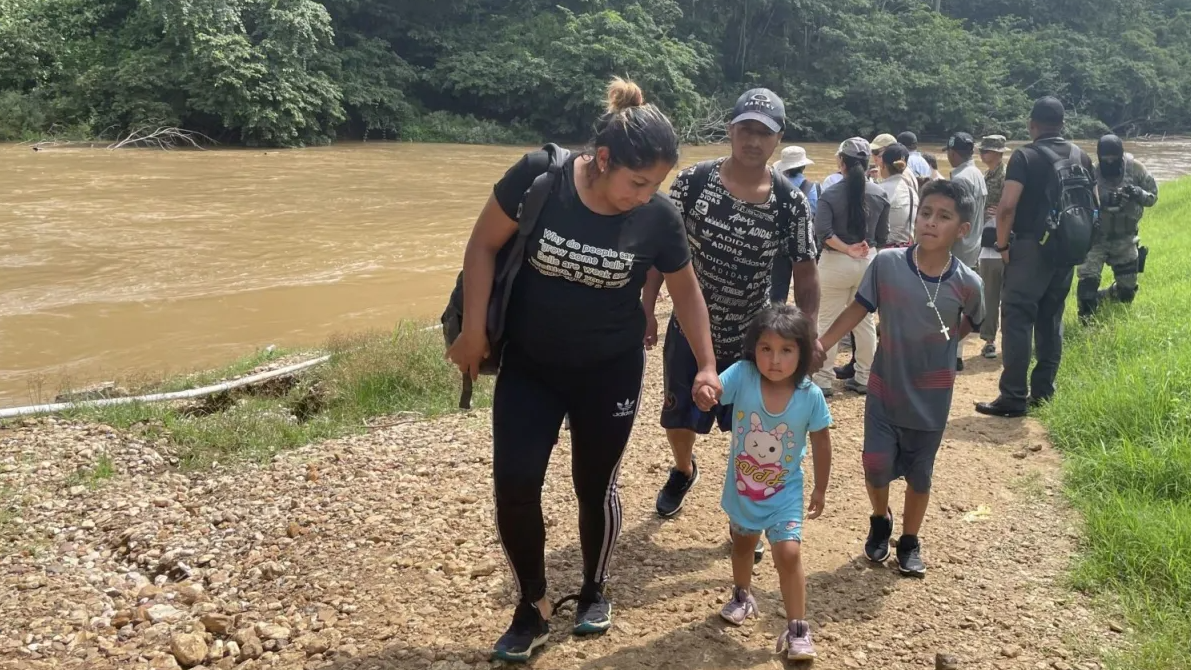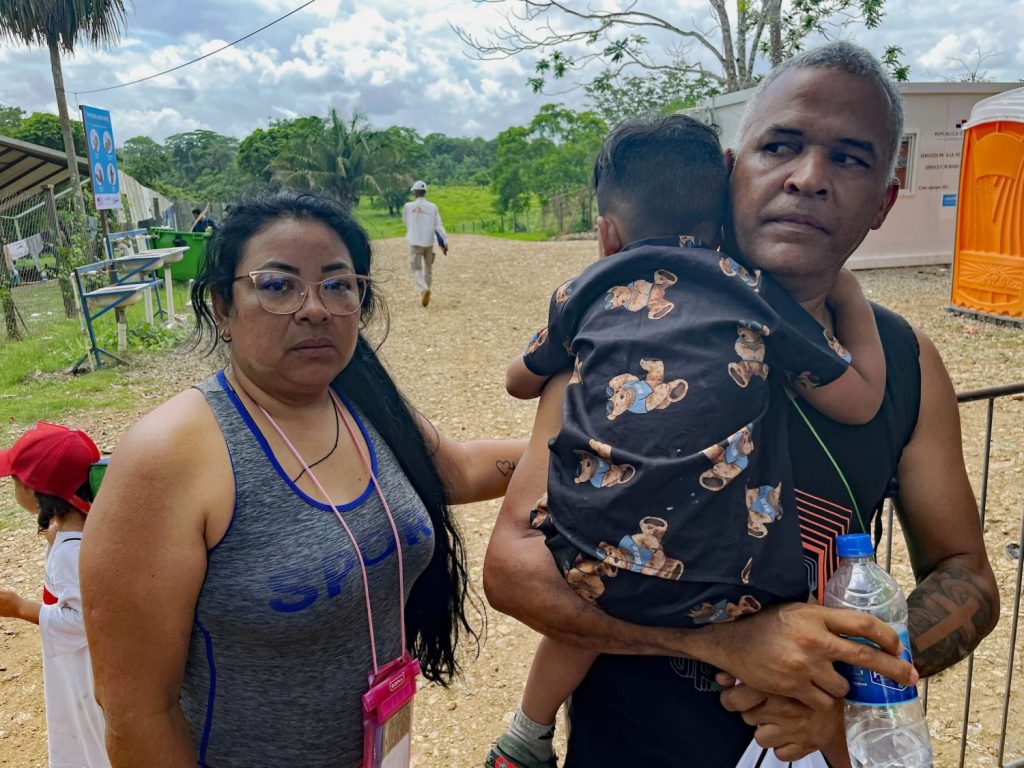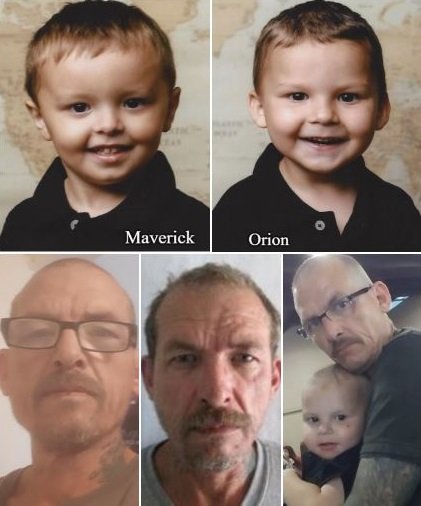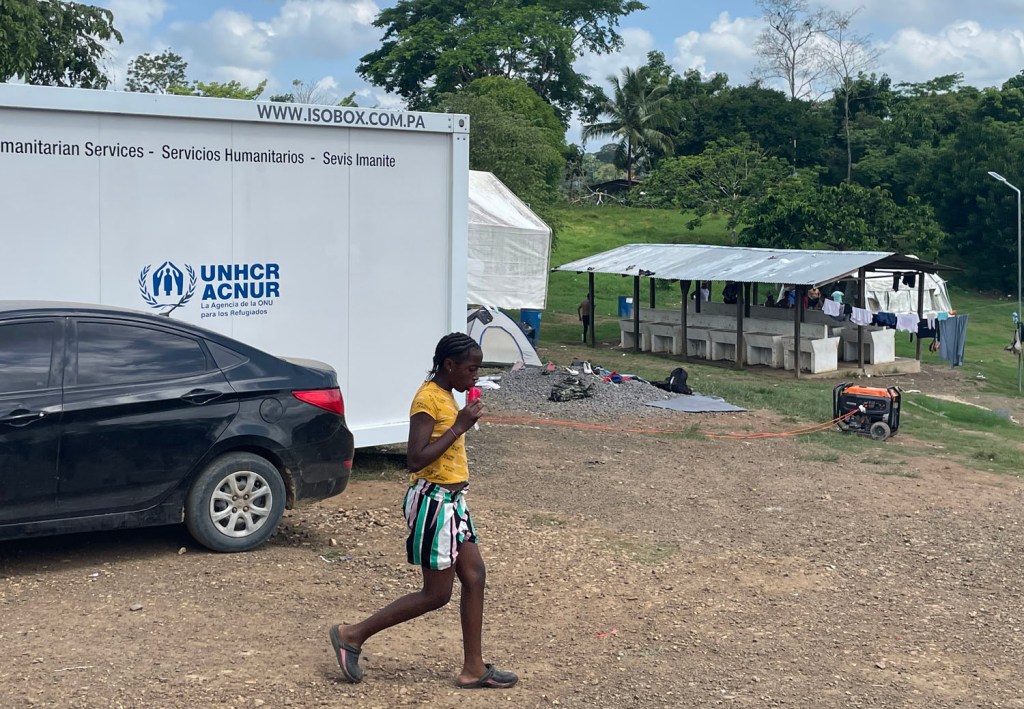Tens of thousands of migrants continue to press through dangerous jungle with hopes of reaching US-Mexico border

by Robert Moore, El Paso Matters
June 27, 2023
LAJAS BLANCAS, Panama – A family from Venezuela climbs from a canoe that has carried them for three hours on the Rio Chucunaque in the Darién jungle. They make their way up a path with a 2-year-old child, tightly in the grip of his grandfather, to check in with Panamanian authorities.
Their vacant stares hint at their trauma.
“Very disturbing. Very, very, very, very disturbing,” the man says in Spanish when asked to describe their four-day journey through the Darién jungle.
“When we arrived to the boats, the river was rising and the people who were coming after us, they died, many died,” his daughter said, sobbing. Their fellow migrants, including some children, were swept into a river swollen by rains. They weren’t sure how many.

No one knows how many people die trying to cross the Darién Gap in Colombia and Panama with hopes of eventually making it to the U.S.-Mexico border. While the Panamanian government collects good records on how many people come out of the jungle, there is no similar count in Colombia of the numbers going in.

But the dangers of crossing through what has long been viewed as an impenetrable jungle is not a deterrent to migrants. Hundreds of thousands who have crossed since 2021 have made their way to El Paso-Juárez and other U.S.-Mexico border communities to find entry into the United States.
Thousands more are on their way.
The number of migrant border crossings in El Paso and other communities on the U.S.-Mexico border has been declining from previous high levels since May 12, when the United States tightened asylum access as it ended pandemic policies that allowed for the quick expulsion of border crossers.
But the continued human flow through the Darién jungle, a key access point for people migrating from South America, raises questions about whether the lower crossing rates at the U.S. border can continue.
On this day, about 500 people will climb from the canoes – known as piraguas – at Lajas Blancas, a village that is the site of one of two migrant reception centers the Panamanian government has established on the edge of the Darién jungle. A similar number will arrive at the other Panamanian reception center in the village of San Vicente.

This day is June 20, World Refugee Day. It’s 70 days after the United States, Panama, and Colombia announced a 60-day plan to “end the illicit movement of people and goods through the Darién.”
That clearly isn’t happening.
What you need to know about the Darién Gap
The Darién Gap is a 60-mile stretch of mountainous jungle linking Colombia in South America to Panama in Central America. The Darién jungle is a national park in Panama and a UNESCO World Heritage Site.
It’s called a gap because it is the only area along the 19,000-mile Pan American Highway from Alaska to Argentina that could not be paved.
Migrant routes through the jungle frequently change. But currently, the most common paths are for people to make their way to Necoclí in northeastern Colombia and take a boat across the Gulf of Urabá to the Panamanian side of the jungle.
The journey through the jungle usually takes three to five days. But for people with injuries or health issues, it can sometimes take 10 days or more. Temperatures usually reach into the 90s, with frequent rain and humidity often 90% or higher.
After migrants emerge from the jungle, people from Indigenous villages like Bajo Chiquito and Canaan Membrillo take them by piraguas to a government reception center a few hours away.
https://youtu.be/vZG9fVUAoOMMigrants aboard piraguas -- canoes -- complete a three-hour journey from Bajo Chiquito to Lajas Blancas in Panama's Darién Gap on Tuesday, June 20, 2023. (Robert Moore/El Paso Matters)
More than 40,000 people crossed the Darién Gap in April, when the multinational plan to close the Darién was announced, and a similar number crossed in May. June is on pace for a similar flow.
Most people crossing the Darién Gap are processed quickly by the Panamanian government and placed on buses to Costa Rica. From there they generally go through Nicaragua, then to Honduras or El Salvador, then to Guatemala, then to Mexico, and eventually to the U.S.-Mexico border.

Stopping – or at least slowing – the movement of migrants through the Darién jungle is a key part of a multinational effort to reduce the number of people trying to come to the United States as they flee poverty, violence and oppression in their home countries.
El Paso Matters was part of a delegation that included experts and advocates in migration, international development and foreign policy who visited Panama June 19-22 to better understand the migration situation in the country, particularly in the Darién. The visit was organized and funded by the Center for Democracy in the Americas, a nonprofit that promotes U.S. engagement with other Western Hemisphere countries that is based on mutual respect.
The delegation met with high-ranking Panamanian, U.S. and United Nations officials, as well as leaders of non-governmental organizations and international relief organizations. The group also met with migrants in Darién and in Panama City, the nation’s capital.

The meetings were off the record, which means that information couldn’t be attributed to people without their permission. But several common themes emerged.
- A third consecutive year of record crossings is expected through Darién. In the first five months of 2023,more than 166,000 people crossed through the jungle, more than the total crossings for the entire decade between 2010 and 2019. More than 400,000 people may cross by year’s end, up from last year’s record of 248,000.
- An increasing proportion of people crossing the Darién Gap are bringing their children. Through May, 20% of people crossing this year have been children – half of them age 5 and younger. In May, the number of children crossing the Darién increased by 5% over the previous month, even though adult crossings were down by 5%.
- Efforts to “close” the Darién are unlikely to succeed. The Colombian government has little presence in that part of their country, which is largely under the control of Clan del Golfo, an organized crime gang. The Panamanian government historically has had little presence in the sparsely populated area that is mostly Indigenous people.
- Migrants crossing the Darién face constant threats from the jungle and from criminals. Sexual assaults and robberies are common. The journey requires multiple river crossings and repeated flooding during the nine-month rainy season in the jungle creates risks of drowning. Insect bites are constant.

- The increase in human presence in the jungle is doing extensive environmental damage to a delicate and important ecosystem.
- The governments of the United States, Panama and Colombia – along with the United Nations – have increased messaging campaigns meant to counter misinformation and disinformation from criminal organizations about the migratory trek through the Darién and to the United States. Those campaigns highlight the dangers of crossing the Darién, and the difficulty entering the United States. But efforts to fight disinformation and misinformation will have limited effect, because hundreds of thousands of people are fleeing desperate poverty and fierce violence. Many of them have heard from family members or friends who made the journey through Darién and on to the United States that the trip is dangerous but possible.
- People from dozens of nationalities from as far away as Asia and Africa use the Darién as a migration path after making their way to Colombia. But about 80% of the migrants crossing through the jungle this year are from Venezuela, Ecuador or Haiti. Many of the Venezuelans and Haitians previously settled in other South American countries, but have been displaced again after the COVID-19 pandemic ravaged South American economies.

- Indigenous people in Darién – who have long lived in poverty with little to no support from the Panamanian or Colombian governments – have made millions of dollars since 2021 by providing services to migrants. The Indigenous people provide canoe rides in the jungle and to government reception camps, and sell food and other items to migrants. These services are legal under Panamanian law. No one seems sure what has happened to the millions of dollars suddenly flowing into an isolated area with no banking infrastructure.
- It’s not yet clear what effects recent policy changes adopted by the Biden administration will have on migration in the Western Hemisphere. The administration is making it more difficult for migrants to request asylum while also offering humanitarian parole to allow thousands of migrants a month to lawfully enter the United States. The changes could reduce efforts to migrate to the United States. Or they could cause more migrants to try to enter the country by evading Border Patrol, often in dangerous crossing areas. Lawsuits have been filed to challenge the reduced access to asylum and the increased use of humanitarian parole, adding to the uncertainty.
- Addressing migration from Central and South America through Mexico and to the United States will require extensive multinational cooperation, including increased regular migration opportunities throughout the hemisphere. The countries most immediately affected by the Darién migration surge – Colombia, Panama and Costa Rica – often struggle to work cooperatively.
A day in the Darién jungle
The Center for Democracy in the Americas’ delegation visited the Panamanian government’s reception centers in Lajas Blancas and San Vicente on June 20.
Most of the people arriving at Lajas Blancas or San Vicente will board buses the same evening bound for Costa Rica. Bus fare is $40 per person for a journey across much of Panama that takes nine to 12 hours.
By the time they reach the buses, migrants have already paid $100 to $350 per person to Clan del Golfo to be able to enter the jungle. With almost 550,000 people passing through the Darién since the beginning of 2021, the Clan del Golfo cartel has raked in $100 million or more through this movement of people.
The migrants then pay $30 for each river crossing requiring a piragua, with at least two such crossings usually required.

Those who can’t pay for the bus stay in government reception centers at the edge of the jungle until they can raise the money, usually by having families at home or in the United States sending payments to a Western Union station in the camp. Panamanian government officials say two seats are made available on every bus for those who can’t pay, and one bus every 10 days is set aside for people who don’t have money.
One Venezuelan family quickly approached the delegation as they walked into the camp at Lajas Blancas.They said they had been in the camp nine days, after a six-day trip through the jungle.
“If we have no money, they won’t let us go,” the father said, adding that his three daughters were vomiting and had fevers and diarrhea. The delegation wasn’t able to ask their names before Panamanian officials asked the group to move on.

His wife was particularly concerned about their youngest daughter, who appeared to be about 3 years old.
“Look how she is,” the mother said, holding up the toddler, whose face and thigh are scarred by what appear to be insect bites and infections. “She lost a lot of weight. She weighed 15 kilos (33 pounds) and now weighs 13 kilos (25 pounds).”
At the Rio Chucunaque, three more piraguas finish the three-hour trip from the Indigenous village of Bajo Chiquito and drop off about 50 more migrants.

Among them were the Venezuelan family traveling with a 2-year-old who had watched as fellow migrants were swept to their death by floodwaters in the jungle.
The Venezuelan man embraced his grandson on the path leading to the Panamanian check-in point, as he had throughout their three-day journey through the jungle. The couple did not give their names.
“I never let go of him, thank God. Never. His needs would always come before mine,” he said.
As he choked up, the man repeated himself. “I never let go of him. Never.”
The family then resumed walking. They hope for a reunion with the man’s brothers and sisters in Texas. They’re not sure exactly where.
“We haven’t been able to communicate with them. We have the phones turned off and we cannot communicate. The river swept off our money,” the man said.
“Everything. We lost everything,” his daughter said. “We lost … we lost the money, we lost everything.”
Panamanian border officials stepped forward. “They are telling us we have to go,” the daughter said.
Correction: An earlier version of this story gave an incorrect description of a Venezuelan couple traveling with a 2-year-old child. They are father and daughter.
This article first appeared on El Paso Matters and is republished here under a Creative Commons license.![]()
